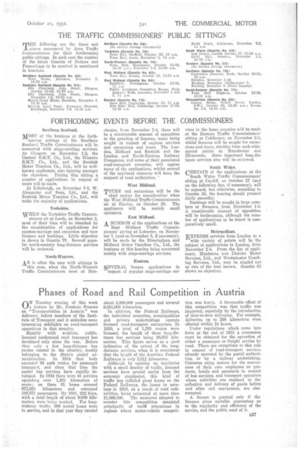Phases of Road and Rail Competition in Austria
Page 63

If you've noticed an error in this article please click here to report it so we can fix it.
ON Tuesday evening of this week n. lecture by Mr. Frederic Strauss on "Transportation in Austria" was delivered before members of the Institute of Transport and it embodies some interesting sidelights on road-transport operations in that country.
Equally with aviation, public, licensed mechanical road transport has developed only since the war. Before then only a few long-distance bus routes existed in the country, . mostly belonging to the State's postal administration. In 1914 that body operated 24 such routes for passenger transport, and since that time the postal bus services have rapidly developed. In 1924 there were 41 services operating over 1,421 kilometres of route; on these 91 buses covered 673,991 kilometres and conveyed 309,871 passengers. By 1931. 232 lines, with a total length of about 9,000 kilometres, were being worked. For longdistance traffic, 606 postal buses were in service, and in that year they carried
about 5,000,000 passengers and covered 9,681,000 kilometres.
In addition, the Federal Railways, the individual countries, municipalities and private undertakings operate licensed road-transport enterprises. In 1930, a total of 1,285 routes were licensed, the length of these long-distance bus services being 26,915 kilometres. This figure serves as a good indication of the extent of the longdistance services, when it is considered that the length of the Austrian Federal Railways is only 5,811 kilometres.
Although by opening up territories with a small density of traffic, licensed services have proved useful from the economic standpoint, this kind of traffic has inflicted great losses on the Federal Railways, the losses in earnings in 1930, as a result of road craTopetition, being estimated at more than £1,000,000. The measures adopted to counter this competition consisted principally of tariff alterations in regions where motor-vehicle competi
tion was heavy. A. favourable effect of this competition was that traffic was improved, especially by the introduction of door-to-door deliveries. For example, deliveries up to 200 kilometres were effected within 24 hours.
Under regulations which came into force at the end of 1931 a concession must be obtained for the operation of either a passenger or freight service by road. There are exceptions to this rule in respect of road-transport services already operated by the postal authorities, or by a railway undertaking. Concerns using motors for the conveyance of their own employees or products, hotels and sanatoria in respect of bus services, and transport operators whose activities are cenfined to the collection and delivery of goods before and after rail conveyance, are also excepted.
A licence is granted only if the licensee gives suitable guarantees as to the regularity and efficiency of the service, and the public need of it.




































































































